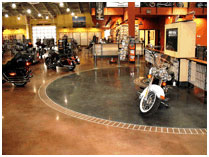Polished concrete is an excellent choice for applications where lower lifecycle and material costs are seen as a priority. By reducing a structure’s initial and ongoing environmental footprint, polished concrete can drastically reduce its overall cost to the environment.
By using polished concrete, the need for the use of other flooring materials can be reduced or eliminated. In addition to reducing the environmental impact associated with the use of other materials, this will also reduce the cost and complexity of the construction process. In many cases, this can also reduce the costs associated with obtaining the permits required for the use of other construction materials. Finally, polished concrete is far more durable than other flooring materials, requiring less in the way of ongoing maintenance, further reducing its environmental footprint.
In addition, the use of polished concrete can shrink the structure’s energy footprint. When combined with a building design that takes advantage of concrete’s superior thermal qualities, polished concrete can dramatically reduce the need for active heating or cooling systems. In addition to reducing the building’s energy costs, the use of polished concrete can also allow for the installation of smaller HVAC systems, which will further reduce the structure’s environmental footprint.
Polished concrete can also dramatically reduce the presence of airborne contaminants such as dust and volatile organic compounds (VOCs) within a building. Additionally, polished concrete does not contribute to the growth of mold. This results in a lessened health risk to building staff and visitors, while also reducing the need for the use of environmentally damaging cleaning materials. These factors help ensure that polished concrete contributes to a healthy and environmentally friendly building environment.
Finally, polished concrete acts to reflect ambient light, reducing the need for artificial lighting sources while enhancing the impact of natural light. This decreases the amount of energy needed for artificial lighting in buildings fitted with polished concrete.
By utilizing polished concrete, either as an initial choice or as part of a building retrofit, it becomes possible to dramatically reduce the structure’s environmental impact and associated financial costs. This makes polished concrete a very attractive choice for many modern building applications.






Comments are closed.